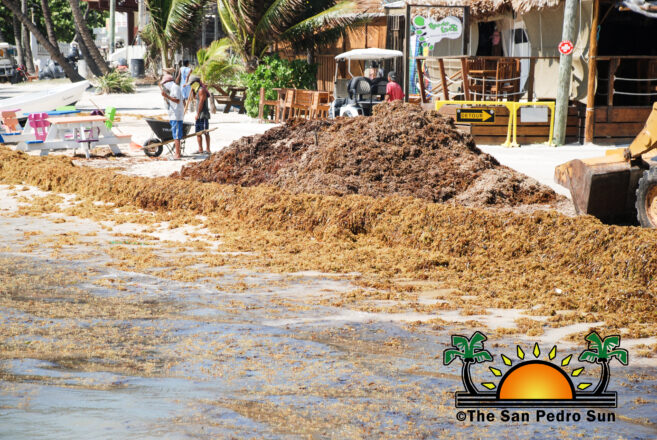A report on the effects of sargassum and management proposals in Quintana Roo, Mexico, and Belize was presented to stakeholders in San Pedro Town on Saturday, October 28th, at the Sunbreeze Hotel. Dr. Minerva Arce-Ibarra, a scientist with the non-profit Ecosur, presided over the informational session.
The main topic discussed was the heavy influx of brown seaweed that has been choking the Caribbean region, Belize, and Mexico over the past years. Its ecological impact on the marine environment has resulted in consequences for coastal communities in their social, economic, health, and cultural aspects. This report, done in collaboration with the Bonefish and Tarpon Trust, is part of a study still in progress and consists of feedback from those affected by the natural phenomenon.
The report highlighted certain areas in Belize and Mexico surveyed. On the Mexican side, the areas surveyed include Xcalak, Mahahual, and Punta Herrero, with the least impact. In contrast, the coastal and tourism communities of Playa del Carmen showed the highest effect, with a medium impact observed in Puerto Morelos and Cozumel. Meanwhile, in Belize, the areas surveyed showing the highest impact were San Pedro, Ambergris Caye (east coast), Caye Caulker, and Tobacco Caye. Other areas studied and showing a medium effect in other parts of the country included Dangriga Town, the villages of Hopkins and Placencia in the Stann Creek District, and Punta Gorda Town in the Toledo District.
Some stakeholders affected in both countries during the sargassum crisis shared their experiences with the massive influx of seaweed. Small-scale fishermen said the seaweed invasion caused a decline in fish for subsistence purposes. The recreational fisher said the impact was medium as they engaged in deep sea fishing. However, their equipment (engines) experienced damage due to the sargassum mats on the water. In the case of tour operators, they had to offer excursions further away from the coast. They noted that such a change affected the quality of their tours and added fuel expenses. National Protected Areas saw less income from tourism. Restaurants in areas of Quintana Roo beachfront restaurants lost about 50% of their business. Businesses in Belize reportedly received a reduction in taxes to help them cope with the losses caused by the unexpected sargassum inundation.
According to Dr. Minerva, the scientific community and local authorities are still looking at ways to manage the unwanted seaweed properly. This seaweed does provide a nursing ground for juvenile marine life, but over the years, it has become a threat to coastal communities, causing a dent in the fishing and tourism industries and even affecting people’s health. Some health issues reported in San Pedro include skin allergies and respiratory complications. One suggestion for managing the algae is to use it as a landfill, set floating barriers and pick it up before it hits the shores, bury seaweed, and even turn it into construction materials.
These suggestions were not considered healthy solutions since sargassum produces hydrogen sulfide and methane. This floating seaweed is also known for containing arsenic and heavy metals.
The Government of Belize has also offered to help find a solution to control sargassum. One idea the current administration is looking forward to is converting sargassum into energy. According to the government, the idea started following a trip to Germany in September 2022 by Belize’s partners involved in the project. Prime Minister Honourable John Briceño shared that after discussions and research, a union called Public-Private Partnership was formed with Belize via signing a Memorandum of Understanding with the German company Variodin, Ag., specializing in energy and waste conversion development technologies. As such, this partnership aims to develop and deploy a multi-purpose waste-to-energy facility in Belize to process waste from municipalities and sargassum to biofuels.
The sargassum crisis has been growing since 2014, becoming a yearly occurrence in the Caribbean Region. Every year during the spring and summer months in Belize and the region, it floods the coasts, killing local marine species along the coastline and affecting thousands of livelihoods.
It has become expensive for countries to deal with the sargassum as well, with an estimation that the Caribbean region spends approximately $120 million annually to collect and dispose of the rotting seaweed off beaches. Just in 2022, the region saw an invasion of some 24 million tonnes of sargassum. The seaweed poses a grave threat to the world’s most breathtaking ecosystem, so large it can be seen from space. The Meso-American Reef is a haven for fish and many marine species, contributing millions of dollars to the Belize tourism and fishing industry.
Currently, there is no sargassum across the Belizean beaches. By the end of February or March of 2024, the seaweed is expected to return to the country and region.

Share
Read more

